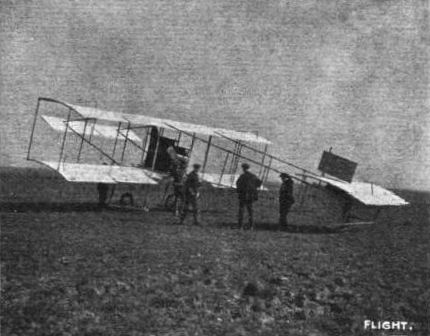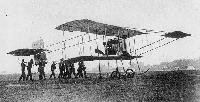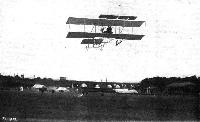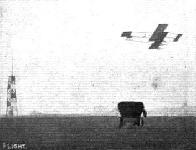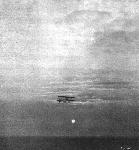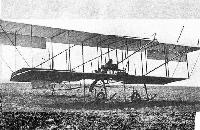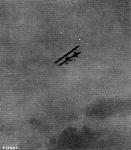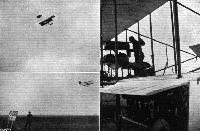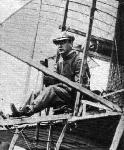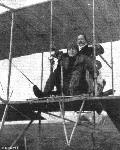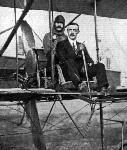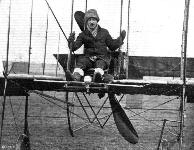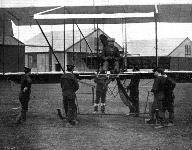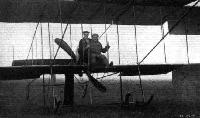C.Barnes Short Aircraft since 1900 (Putnam)
Short Pusher Biplanes (1910-14)
On 15 February, 1910, H.M. King Edward VII granted the prefix ‘Royal’ to the Aero Club of the United Kingdom, in recognition of the growing importance of aviation and of the Club’s contribution to the art of flying. Many new members were attracted, some of whom might earlier have doubted the respectability of a movement so near the ‘lunatic fringe’, and a London headquarters had been opened at 166 Piccadilly. This was well patronised, although the hardier members preferred to spend their time at Mussel Manor, their Club-house at Shellbeach, near Leysdown, Sheppey; but the adjacent flying ground was small and much restricted by numerous dykes and rough areas. Horace and Eustace Short owned an ancient 7 hp Panhard car which apparently took such obstacles in its stride, and in this they explored the entire Isle of Sheppey, eventually discovering 400 acres of excellent level grassland adjoining Stamford Hill near Eastchurch, about four miles east of Leysdown. Frank McClean then purchased this as an auxiliary flying ground and invited Short Brothers to move their works to it. The Leysdown works were still completing the last two Short-Wrights and Short No. 3, but only Charles Rolls and Alec Ogilvie still thought this type had any future after having seen the standard Farmans flown at Reims in August 1909 by Henry Farman, George Cockburn and Roger Sommer. Horace Short considered the Wright to be ‘a beast that needs some handling’, and he and Frank McClean readily accepted the view of George Cockburn and Cecil Grace that the Farman was easier to fly, cheaper to construct and maintain, and had more development potential, particularly when allied with the 50 hp Gnome rotary engine. By March 1910 Rolls, too, had come to the same conclusion, for he had bought one of the latest Sommer biplanes, which he showed at Olympia and flew briefly at Eastchurch in April, before going to Nice.
In May 1910, having completed the sixth Short-Wright at Leysdown for Rolls, Short Brothers moved their factory to Eastchurch, where they had plenty of room for future expansion, and began production of a batch of biplanes designed by Horace Short on the basis of both the standard Farman and Sommer’s derivative of it. The first four were similar, two having 40 hp Green engines, for Frank McClean and J. T. C. Moore-Brabazon respectively, one having a 60 hp E.N.V. for Cecil Grace and one being a reserve airframe. The works Nos. were S.26 for McClean, S.27 for Grace and S.28 for Moore-Brabazon, but they were generically called the ‘S.27 type’, because Cecil Grace was their foremost exponent at flying meetings. The wings were of equal span, with four uncompensated ailerons, and the front elevator was in two parts joined to a central lever directly connected by wires to the pilot’s control lever; the span of the front elevator extended beyond the pivots carried by the front booms. The tail-booms were parallel in plan, but slightly convergent rearwards in side view, as in the Sommer, and carried a cambered monoplane tail having a narrow-chord inset elevator linked to the front one, with a square rudder pivoted centrally below; this single rudder was adequate for the Green-engined version, but Grace preferred to augment it by a similar rudder above the tailplane when using the E.N.V. The landing-gear, like Sommer’s, was simpler than Farman’s, with the skids wire-braced laterally, carrying only a single wheel inboard of each skid. The wheels were mounted on a long rubber-sprung cross-axle, which was soon found to be too flexible and was thereafter stiffened by an ingenious truss of kingposts and bobstays. As in the Sommer, malacca cane half-hoops below each lower tail-boom formed the tailskids.
Although the exact first flight date of the new Short biplane is not on record, it is known that both S.26 and S.27 were being flown on 19 June, 1910, the former by G. C. Colmore, a beginner with only 20 minutes taxying time to his credit; nevertheless, his first flight covered 11 miles in 20 minutes, and the next day he completed the tests for his pilot’s certificate (No. 15), which the Royal Aero Club granted on 21 June, 1910. Cecil Grace began flying S.27 about the same time, and on 20 June flew for 45 minutes over Sheerness, circling above the battleships Bulwark and Victorious and reaching a height of 1,180 ft, a new British record; he reported that the ailerons designed by Horace Short were quite as effective as the Wright warping system, thus resolving a doubt which had hitherto existed. At the Midland Aero Club’s meeting at Dunstall Park, Wolverhampton, from 27 June to 2 July, he gave a brilliant display of manoeuvrability for half an hour, finishing with a deadstick landing from 150 ft. Moore-Brabazon took delivery of S.28 during the last week of June and flew it once or twice at Eastchurch; He had entered it for the Bournemouth meeting on 11 July, but did not fly there, although both Colmore and Grace took part on S.26 and S.27. After the death of Rolls on 12 July Moore-Brabazon was persuaded by his wife to give up competitive flying and S.28 was stored for the time being at Eastchurch. Colmore flew S.26 in the Lanark meeting, where he covered the flying kilometre at 52-75 mph, but in trying to improve on this on 13 August he came to grief in a young fir plantation. After repairing the damage, McClean had a 50 hp Gnome fitted to S.26; at the same time a flat tailplane with a larger aft elevator was fitted and the front elevator was reduced in span, with levers at each side to carry the control wires linking the two elevators; this arrangement became standard on all future Short biplanes of this type. McClean flew S.26 thus modified on 31 August and made rapid progress. Completing his tests for R.Ae.C. certificate No. 21 on 19 September he made several cross-country flights, but damaged S.26 in a heavy landing on 30 September; a stronger chassis with diagonal struts was fitted, together with stronger tailskids, and he was flying again on 15 and 16 October, watched by a party of Naval officers from Sheerness, whose interest had been aroused by Cecil Grace’s exploits; on 22 October McClean took up as his first passenger Dr W. J. S. Lockyer, his old friend and colleague in astronomy, who was also a keen balloonist and a pioneer of aerial photography.
McClean next bought S.28 from Moore-Brabazon and had it fitted with a 50 hp Gnome, flying it in this form on 15 November, 1910. After two weeks’ flying he substituted a 60 hp Green engine, so as to make it an all-British aeroplane and thus eligible for the de Forest Prize of £4,000, which was on offer till the end of 1910, for British subjects on British aircraft only, for the farthest distance flown from a starting-point in England to a point on the Continent. By coincidence, Baron de Forest’s announcement of this prize had been sent to the Aero Club on 25 July, 1909, the day Louis Bleriot flew the Channel, but before the news of Bleriot’s feat had reached London. Cecil Grace, too, was competing in S.29, which had been completed with a 60 hp E.N.V. engine and a number of other modifications, including flotation airbags and extensions to the upper wing-tips. Grace flew S.29 to his starting-point at Dover on 5 December, but McClean had engine trouble with S.28 and abandoned his attempt on 18 December, when the weather became very rough. Grace decided to discard the flotation bags and took off from Dover on the 22nd, making an excellent flight to Les Baraques in spite of bad weather; he decided to fly back at once to make another attempt and was heard near the North Goodwin lightship in fog, but never reached Dover, nor was ever seen again.
A few weeks earlier Frank McClean, through the Royal Aero Club, had offered the Admiralty the free use of two Gnome-engined Shorts (S.28 and S.29), and Cecil Grace had offered to give free tuition on them. This offer was to remain open for six months, during McClean’s absence, as a representative of the Norman Lockyer Observatory, with a Government Solar Eclipse Expedition to Fiji and Tasmania; Dr Lockyer was in charge of the party, which sailed on 31 January, 1911, in the cruiser Encounter and was due to return in July after recording the eclipse on 28 April. On 5 December, 1910, in a General Fleet Order, Admiral Sir C. C. Drury, C.-in-C. The Nore, invited applications from Royal Navy and Marine officers to join the flying course, and 200 volunteers sent in their names. After Cecil Grace had been presumed dead, George Cockburn offered to take his place as instructor, and a new biplane, S.34, was built to replace S.29. The first four officers selected for the first course were Lieuts C. R. Samson, A. M. Longmore and R. Gregory of the Royal Navy and Lieut G. V. Wildman Lushington of the Royal Marine Artillery. Cockburn began instructing Samson on S.28 on 15 March, but Lushington was on sick leave, and his place was taken by Lieut E. L. Gerrard, Royal Marine Light Infantry. Samson and Longmore qualified for R.Ae.C. certificates on 24 April, and Gregory and Gerrard on 1 May; all four were airborne on 11 May when Prince Louis of Battenberg (commanding Reserve Fleet, Sheerness) paid the first of many visits to Eastchurch. At the start of the course McClean’s S.26 had also been made available for instruction, but it was found sluggish compared with the later machines and was only used for preliminary taxying lessons; it was known as ‘The Dud’, and when S.28 (‘Little Willy’) began to accumulate flying time it was deemed wise to have another machine in reserve, so a new biplane, S.38, similar to S.34, was built to replace S.26 and was first flown by Samson on 24 May, 1911. Like S.34, its upper wing spanned 46 ft and it had top and bottom ailerons. The bottom ailerons had been deleted at Cecil Grace’s request on S.29, because of flexibility in the bottom wing spars, but Horace Short had found an answer to this problem by means of kingposts in the inner bays above the spars and in the centre bay below the spars; at the same time the whole wing truss had been strengthened by solid compression ribs below the lower surface of the upper wing, between the interplane strut top sockets. Thus the ‘improved S.27’, as it was known, was notable for its robust construction, although its open accommodation, with the passenger behind and above the pilot, was spartan in the extreme.
In July both S.34 and S.38 were prepared for maximum duration flying, and S.34 was equipped with extra large tanks for 28 gallons of fuel and 13 gallons of oil. S.38 had been built with tankage for four hours, but this was supplemented by a gravity tank mounted fore-and-aft above them; S.38 also sported fabric wheel covers at this stage of its career. On 17 August Lieuts Gerrard and Lushington flew S.34 for 4 hours 13 minutes, then landing only because of dusk, with over two hours’ fuel remaining. Two days later Samson flew solo in S.38 for 4 hours 58 1/2 minutes to set up a new British duration record. During this flight his watch stopped, so he circled the flying ground calling in a stentorian voice for a time-check, which was thereafter displayed at five-minute intervals, chalked large on a blackboard. When the six months’ agreement expired on 31 August, 1911, it was reckoned that ‘Little Willy’ had flown 4,000 miles, and S.34 and S.38, 3,000 and 2,000 miles respectively; the total breakage bill incurred was only £25.
While the four Naval airmen were perfecting their skill, two more variants of the ‘improved S.27’ appeared from the works.
<...>
The second S.27 variant was S.32, which was ready for Frank McClean on his return from Tasmania; he made the first flight on it on 29 July, 1911. This biplane had begun in November 1910 as a tractor design for Cecil Grace, but had been set aside after his death and then completed as a pusher at McClean’s request. It had a 70 hp Gnome and was the first Short biplane to feature side-by-side seats with full dual controls; this made it particularly suitable for school work and, following the success of the Naval pupils, McClean offered similar free tuition on this machine and another like it, S.33, to volunteers from the London Balloon Company, R.E., T.F. In November 1911 the first ‘Terrier’ pupils began flying lessons under Jack Travers, one of Shorts’ draughtsmen, who had already gained his pilot’s certificate at Brooklands; the first to qualify was V. A. Barrington-Kennett (whose more famous brother was a few months later to become the first Adjutant of the Royal Flying Corps); he went solo on 6 December and gained his certificate (No. 198) on 5 March, 1912. By this date, however, the War Office was committed to expand the Air Battalion, R.E., into the Royal Flying Corps, and ruled that members of Territorial Balloon Companies were not to indulge in aeroplane pilotage, so McClean had to end the free training scheme, but not before three more ‘Terrier’ pilots, including Tom O’Brien Hubbard, had won their brevets. Two more dual-control school biplanes, S.43 and S.44, were built for the new Central Flying School at Upavon, being tested by McClean at Eastchurch early in June 1912 and delivered to Upavon in July, after official scrutiny and acceptance at Farnborough; they were serialled 401 and 402. Although their discomfort made them unpopular, their indestructibility earned them respect, and they were still in daily use late in 1914.
<...>
S.26-28 (original) - Span 34 ft 2 in (10 3 m); length 40 ft 6 in (12 3 m); area 480 sq ft (44-6 m2); empty weight 1,000 lb (454 kg); loaded weight, 1,400 lb (635 kg); speed 40 mph (62-9 km/h).
S.29, S.32-35, S.38, S.43-44 - Span 46 ft 5 in (141 m); length 42 ft 1 in (12-8 m); area 517 sq ft (48 m2); empty weight 1,100 lb (500 kg); loaded weight 1,540 lb (700 kg); speed - 50 hp Gnome, 39 mph (62-8 km/h); 70 hp Gnome, 45 mph (72-5 km/h).
Postscript. As this book went to press, confirmation arrived from Mr Gascoyne (formerly of the E.N.V. Co.), via Mr H. F. Cowley, that the French-built 60 hp E.N.V. engine (Type F, series 1, No. 4), discovered in 1964, was indeed the engine originally installed in S.27 and flown by Cecil Grace at Wolverhampton and Bournemouth in 1910. This engine had been stored since 1914 at the Chequers Inn, Eltham, Kent, and was in running condition when found by a Mr Tagg. Only British-built E.N.V.s were eligible for the de Forest competition, and it was one of the first of these that was lost in Grace’s S.29; two others were installed in T. O. M. Sopwith’s winning Howard Wright and in Grahame-White’s unlucky Bristol Boxkite.
M.Goodall, A.Tagg British Aircraft before the Great War (Schiffer)
Deleted by request of (c)Schiffer Publishing
SHORT biplanes, pusher types S26-S29
The Short brothers discontinued the manufacture of Wright type aircraft and changed to those similar to the Farman/Sommer types. The change coincided with the move to Eastchurch and identification by construction numbers beginning at S26. The first production was a batch of four aircraft S26-S29, which were usually referred to as the S27 type, this being the machine which was most successful in the hands of Cecil Grace. The first of the type appeared in June 1910.
The S27 type was a typical pusher biplane of the period with either equal span wings or with top wing extensions. The undercarriage was a simple two wheel, two skid arrangement and the tail was supported by hoops of rattan cane under the booms, although a sprung tail skid was soon fitted. Single acting ailerons were originally fitted to all four wings but Grace had these removed from the lower wings, which suffered from flexibility and which were stiffened at the same time.
The front elevator was split in two and originally extended outboard of the front booms but these extensions were later removed. The rudder was originally one rectangular surface below the tailplane but, when this proved to be inadequate, a similar rudder was mounted above the tailplane. A section of the tailplane trailing edge was hinged and controllable by the pilot as a trimming control.
Water-cooled Green and ENV engines were used originally but later the air-cooled Gnome rotary was fitted. The four aircraft of the type were as follows:
S26. 35/40hp Green: For G.C. Colmore, originally under No.S18, not completed. The machine crashed but was rebuilt and passed to F.K. McClean (McClean No.3), who loaned it to the Navy for pilot instruction. It survived until April 1911, but was sluggish on the controls and known as 'The Dud'. (Naval biplane No.l)
S27. 60hp ENV French-made type F Series 1 No.4: C.S. Grace No.2. Flown by him at Wolverhampton, Bournemouth, Lanark and elsewhere from June 1910. After Grace was lost in December 1910 the aircraft was sold to McClean and converted to become the Tandem Twin with two 50hp Gnome engines. (McClean No.7 became No. 11 after conversion)
S28. 35/40hp Green also 50hp Gnome: For J.T.C. Moore-Brabazon, but transferred to F.K. McClean after Brabazon gave up flying in July, and allocated to the Navy for pilot instruction. (Naval Biplane No.2) Converted for longer range as S38 from May 1911. (Moore-Brabazon No.6. McClean No.5)
S29. 60hp ENV British-made type F: Originally a spare machine but became C.S. Grace No.3 as an all-British machine, to compete in the Baron de Forest Contest. This was the machine in which Grace was lost on 22 December 1910 in the Channel, when returning to England for a second attempt for the Prize
Data
Span 34ft 2in (46ft 5in with extensions)
Chord 6ft 9in
Gap 6ft 4in
Area 480 sq. ft (517 sq. ft with extensions)
Length 40ft 6in
Weight 1,000 lb.
Weight allup 1,400lb.
Speed 40 mph
S32. Pusher biplane, dual-control type (Refers also to S33, S43 and S44)
S32 was acquired by McClean, and was rebuilt for him as a dual control side by side pusher, which he flew for the first time on 29 July 1911, before lending it to the Navy (McClean No.8).
S33 was a similar machine, which he lent for a short time to the Army for training Territorials. Two more of the type, S43 and S44 were built for the Central Flying School at Upavon becoming Nos.401-402 in the service. These machines were of the same basic S27 type with wing extensions and a 70hp Gnome rotary engine. An additional rudder was fitted above the tailplane. Originally, No.13A in McClean's fleet, S33 was converted to a floatplane for a flight along the Thames on 10 July 1912, then identified as No.13B.
In early 1913 S32 was again rebuilt for McClean to a new standard similar to the S38 type, then becoming McClean No. 14. The machine was provided with a nacelle with tandem seating for two, with a structure at the prow carrying the front elevator. The tail booms were parallel in elevation, but tapered slightly in plan. A rectangular tailplane and elevator were mounted on the top boom and twin rudders pivoted between the booms. A 70hp Gnome was fitted. The wings were extended by a further bay each side to a span of 70ft 6in, with dihedral and taper on the leading edge, outboard of the second pair of interplane struts. Kingposts supported the upper wing extensions.
S32 was intended to be a seaplane to take to Egypt to explore the River Nile, but in this form it was unsatisfactory, and was replaced by S80. S32 was passed to the Admiralty and later rebuilt as S38 with 52ft span wings and duplicated landing wheels. It became serial No.904 and was used for training purposes at Hendon.
Power: 70hp Gnome seven-cylinder air-cooled rotary
Data After Rebuild as S38
Span 46ft 5in 70ft 6in 52ft
Area 517 sq. ft 772 1/2 sq. ft 580 sq. ft
Length 40ft 6in
Weight 1,150lb.
Weight allup 1,540lb.
Speed 45 mph 38 mph
P.Lewis British Aircraft 1809-1914 (Putnam)
Short S.27
The completion at Eastchurch of the S.27 for Cecil S. Grace in May, 1910, was an abrupt breakaway from previous Short Wright-type biplanes, and conformed to the successful Farman-style boxkite then proving popular. Several were built and were powered by the 40 h.p. "D" and 60 h.p. "F" E.N.V. engines, various modifications being made as experience was gained with the type.
Grace quickly became proficient on his S.27, and flew it at the Wolverhampton Aviation Meeting held from 27th June until 2nd July, 1910, at Dunstall Park by the Midland Aero Club. Six months later, he disappeared while flying the English Channel on 22nd December, using the 60 h.p. E.N.V. version of the same machine. The endurance of the S.27 was good, seven hours being attained on twenty gallons of petrol.
The type proved itself to be a useful and practical flying machine and, as the modified S.27, it was altered in succeeding versions, upper wing-tip extensions bringing the span to 46 ft. Other variants of the basic design were built, the engine being changed to the 50 h.p. Gnome. The occupants were protected by being seated in a nacelle instead of being exposed in the open as hitherto.
The modified S.27 to achieve greatest fame was No. 38 of the Admiralty. This was fitted with three air-filled torpedo-shaped flotation bags attached to the undercarriage and the tail, and on 1st December, 1911, was flown by Lt. A. M. Longmore, R.N., from Eastchurch and landed on the River Med way. It afterwards flew back to Eastchurch. Just over a month later, on 10th January, 1912, Lt. C. R. Samson, R.N., performed the feat of taking-off in the same machine from a staging built over the forepart of H.M.S. Africa, the ship remaining at anchor in Sheerness Harbour. Lt. Samson used No. 38 to do the same from H.M.S. Hibernia on 9th May, 1912, at the Naval Review at Weymouth while the ship was steaming at 15 knots. The long-suffering machine was modified once again during 1912 to take the 70 h.p. Gnome, and the wing span was increased to 52 ft. A covered-in nacelle was installed, the aeroplane becoming one of the first to be fitted with wireless. Armament experiments were carried out, also, by fitting a gun for the observer's use. By the time that all of the alterations had been incorporated, in October, 1912, the modified S.27 No. 38 had become virtually the prototype for the S.38/T.2.
Two S.27s belonging to F. K. McClean were used at Eastchurch for training the first naval pilots, Lts. R. Gregory, A. M. Longmore and C. R. Samson, R.N., and Lt. E. L. Gerrard, R.M.L.I. Under G. B. Cockburn for flying tuition and Horace Short for technical instruction, they started their course on 2nd March, 1911, and received their Royal Aero Club Aviators' Certificates after a few weeks. Samson and Longmore were awarded Nos. 71 and 72 respectively on 25th April, and Gregory and Gerrard Nos. 75 and 76 respectively on 2nd May. Six months later, in October. 1911, the Admiralty bought the S.27s from McClean and set up at Eastchurch what was to become the well-known naval flying-school. During 1912 the S.27 type was given the naval designation T.1.
On 10th August, 1912, McClean created a sensation when he flew his S.27 up the River Thames, passing between the spans of Tower Bridge and under the rest of the bridges to Westminster.
SPECIFICATION
Description: Two-seat pusher training biplane. Wooden structure, fabric covered.
Manufacturers: Short Brothers, Eastchurch, Isle of Sheppey, Kent.
Power Plant: 40 h.p. E.N.V. "D", 60 h.p. E.N.V. "F", 50 h.p. Gnome, 70 h.p. Gnome.
Dimensions:
(S.27) Span, 34 ft. 2 ins. Length, 40 ft. 6 ins.
(Mod. S.27) Span, 46 ft. 5 ins. Length, 42 ft. 1 in. Wing area, 517 sq. ft.
Weights: (Mod. S.27) Empty, 1,100 lb., with 50 h.p. Gnome; 1,150 lb., with 70 h.p. Gnome.
Performance: (Mod. S.27) Maximum speed, 39 m.p.h., with 50 h.p. Gnome; 48 m.p.h., with 70 h.p. Gnome. Endurance, 4 hrs., with 50 h.p. Gnome; 5 hrs., with 70 h.p. Gnome.
O.Thetford British Naval Aircraft since 1912 (Putnam)
SHORT S.27
This box-kite biplane, fitted with an eight-cylinder E.N.V. engine, first appeared in 1910, and provided the basis for a series of Short biplanes, all of which were used in the earliest days of naval flying in Great Britain when Royal Navy officers were trained at the Royal Aero Club aerodrome at Eastchureh, at first on aeroplanes privately owned by Mr Frank McClean and loaned to the Admiralty. Maximum speed, 40 mph. Span, 34 ft 2 in. Length, 42 ft 1 in.
SHORT IMPROVED S.27 SERIES
These aeroplanes were a development of the S.27 from which they differed in having strut-braced extensions to the top wings. Later models were also to be seen with a small nacelle for the pilot and passenger. The most famous of the modified S.27s was S.38 (RNAS No.2), which was fitted with three air-bags (attached to the undercarriage struts and beneath the tail) enabling it to alight on water. On 1 December 1911 this feat was achieved by Lt A M Longmore (later Air Chief Marshal Sir Arthur Longmore), who flew the S.38 on to the River Medway. On 10 January 1912 Lt Samson used the same aeroplane to make the first take-off from the deck of a British warship (HMS Africa) whilst it was at anchor off Sheerness. On 9 May 1912 this performance was repeated from the deck of HMS Hibernia as it was steaming in Weymouth Bay at 10 l/2 knots, and again from HMS London on 4 July 1912. The improved S.27 was fitted with a single 50 hp or 70 hp Gnome rotary engine. Maximum speed, 48 mph. Span, 46 ft 5 in.
Jane's All The World Aircraft 1913
SHORT BROS. Works and flying grounds: Eastchurch, Isle of Sheppey, Kent. London office: Queen's Circus, Battersea Park. Took up construction at a very early date. Wright agents in 1909. Have built numerous biplanes and monoplanes to specifications. Produced their own first machine (see 1911 edition) in 1910.
S 34. Standard School.
50 h.p. 70 h.p.
2-seater. 2-seater.
Length................feet(m.) 42 (12.85) 42 (12.85)
Span..................feet(m.) 46? (14.20) 46? (14.20)
Area.............sq. feet(m?.) ... ...
Weight, machine......lbs.(kg.) 1100 (500) 1150 (523)
useful.......lbs.(kg.) ... ...
Motor.....................h.p. 50 Gnome 70 Gnome
Speed, max............(m.p.h.) 39 (63) 48 (78)
min............(m.p.h.) 34 (55) 38 (61)
Endurance.................hrs. 4 5
Number built during 1912 ... ...
Solely designed for school work. Seats side by side.
Журнал Flight
Flight, June 4, 1910
A NEW SHORT BIPLANE, "No. 27."
A NEW biplane has just been constructed by Messrs. Short Bros., and flown by Mr. C. S. Grace, who bids fair to become one of our leading, if not actually the most expert aviator in Great Britain. The biplane is, as a mere glance at our accompanying photograph is sufficient to show, an entire departure in design so far as Short Bros.' previous practice is concerned. It embodies features, however, that are at any rate superficially suggestive of the Sommer and Henry Farman machines, and when we speak of these designs it is, perhaps, only fair to give credit to the pioneer house of Voisin, on whose original plans they were grafted.
It should be quite unnecessary to say concerning any work executed by Short Bros., however, that the design and construction are in every detail as original as if they bore no likeness to anything that anyone else had done. The machine, as the illustration shows, is a biplane that has a monoplane tail. Above and below the tail plane are the rudder planes, and in front of the main planes is a monoplane elevator. The trailing edges of both main planes, from the extremity to the next strut, are hinged so as to serve as balancing flaps. The machine is driven by an 8-cyl. E.N.V., mounted on a special framework. To the design of this framework the greatest possible care and attention is devoted, for the pilot sits in front of the engine, and in the event of a catastrophe it is most important that he should be rendered as little liable as possible to have it break away and fall on top of him. After a series of very successful flights, a mishap occurred that would have resulted in this very calamity, had not the structure behaved in the manner that was intended.
It will be observed from the photograph that the position of the machine at rest is such as to give a very considerable angle of incidence to the main planes. The tail plane is so adjusted, however, that it lifts when the slip stream of the propeller is coupled with a very low velocity over the ground, and consequently when the machine has advanced only a few yards it assumes its flying position automatically, and is very quickly in the air. The attitude of the main planes in flight is such as to give an extraordinarily small angle of incidence - this, together with the remarkable speediness of the machine (about 45 miles an hour) being the outstanding feature of this latest important Short development.
Flight, June 25, 1910
NEW BRITISH ALTITUDE RECORDS.
MOUNTED on his Bleriot machine, Mr. Armstrong Drexel on Saturday evening, at the New Forest Aviation School ground, succeeded in beating the British height record and taking it to 1,070 feet; but on Monday evening this was bettered by Mr. Cecil Grace at Eastchurch, on his new Short machine, which was fitted with an aneroid barometer. Mr. Grace steadily rose to a height of 1,180 feet, and then, switching off the ignition, glided down to earth. The gliding angle of his machine is about 15°. There was a strong wind blowing, and at times the machine was quite stationary in the air.
Flight, November 19, 1910
FROM THE BRITISH FLYING GROUNDS.
Royal Aero Club Ground, Eastchurch.
THE weather here during the past week has been very squally, but the short spells experienced in which it was at all possible to venture out have been taken full advantage of by Mr. McClean on his Gnome-engined "Short" biplane.
On Wednesday, the 9th inst., he brought out this machine, and despite a stiffish breeze immediately rose to about 100 ft. He was content, on this occasion, to remain within the immediate vicinity of the grounds, flying in circles and figure eights and executing several successful vols plane, at which, by the way, he is becoming quite an adept. One of these exhibitions was particularly clean, the machine approaching to within 15-20 ft. of the ground before the engine was re-started. Later in the day Mr. McClean was again seen to advantage, on this occasion making several short trips carrying a lady passenger.
On Thursday, the 10th, Mr. McClean again brought out his machine and made a splendid flight of over an hour's duration. He frequently passed over Harty and the surrounding country, returning each time along the coast line, and ultimately effecting a good landing from a steady vol plane of some 150 ft.
Friday was an impossible day, but on Saturday Mr. McClean beat all his previous performances by remaining aloft for well over an hour and a quarter. His journeyings on this occasion extended over Harty and Shellbeach on the one side, and Queenborough and Sheerness on the other.
Mr. McClean's performances this season have been consistently good, and his total mileage since July now stands well over 600. His machine has behaved splendidly, and has not given the slightest trouble since leaving the works.
Mr. Jezzi was out for some time on Saturday on his biplane testing the efficiency of the power plant in its new position, this having recently been altered to the front of the machine. Mr. Grace is trying a similar experiment on one of his "Short" biplanes, and we shall hope to give some particulars of the trials of both these machines, which will be held during the next week if weather conditions are favourable, in our next issue.
Sunday and Monday were blank days, the weather being wretched.
On Tuesday, the 15th inst., Mrv McClean brought out his latest "Short" biplane. This is on the lines of the Farman, but embodies all the original features of Short Bros', productions. The machine was only completed on Monday, but after devoting about half-an-hour to the tuning up of its Gnome engine, Mr. McClean essayed a short trial. She rose at the first attempt in about 100 yards or so, and flying at about 50 ft. Mr. McClean completed several circuits before bringing her down. After lunch Mr. McClean was quickly off the mark, rising sharply to a height of some 150 ft. Keeping at this altitude he completed eight or nine circuits of the ground in good time, when he landed for a few further adjustments to the engine. Shortly afterwards he made a further flight, and this time gave a good exhibition of "planing." These three flights represented a total of some three minutes short of the hour - not bad for the first spin. The machine rides the wind beautifully, answers to the helm readily, and from all appearances will develop a good turn of speed when the engine is thoroughly tuned up.
Flight, December 31, 1910
THE DE FOREST CROSS-CHANNEL PRIZE.
The Disappearance of Mr. Grace.
THE one absorbing topic among those interested in aviation and flying matters during the past week has been the mysterious disappearance of Mr. Cecil Grace, and although we are still hoping against hope that he may yet be found, the worst fears have to be entertained, as it is patent to all who have experience of such matters that so long without news of any sort is terribly ominous of the worst. It is now a matter of history of how in his attempt to beat Mr. Sopwith's record for the Baron de Forest's prize Mr. Cecil Grace left Dover about 9 o'clock on the morning of December 22nd and flew over to France, where after making a wide circle over the country he landed at Las Baraques, near Calais. Mr. Grace decided to come down, as the conditions and the wind militated against any chance of doing better than Mr. Sopwith. By half-past two, taking advantage of a lift in the haze, Mr. Grace determined to fly back to Dover in order to be ready for a fresh attempt on the prize. He had previously arranged with the captain of the mail boat "Pas de Calais" to start from France some time after the boat left and follow its course by the smoke. The mail boat, however, was some ten minutes late in leaving Calais and Mr. Grace passed out to sea before she left, there to encounter a bad sea fog by which he appears to have been entirely engulfed. Since then nothing has been heard of Mr. Grace except that it was reported from the North Goodwins Lightship that an aeroplane had passed over the vessel, while a coastguard at Ramsgate declared that he heard the noise of an aeroplane's engine at a point which he estimated to be six miles off the shore. The skipper of a Ramsgate fishing smack also reported having seen a biplane when fishing to the south-west of the East Goodwins Lightship.
On Friday, the 23rd, on the urgent representations of the Royal Aero Club, the Admiralty officials at Sheerness and Chatham readily did everything that they could to assist in a most strenuous search for Mr. Grace. On Sunday morning the Aero Club officials were startled to receive a cable message from Lima, Ohio, to the following effect:- "Grace landed with machine in crevice under high cliff, exact location unknown." To this a reply was sent asking for further details, when the following message was received:- "Dropped on shore, not water. Could not rise above cliff. Request British east coastline people to search water's edge minutely." Under the distressing circumstances, even so curious a chance as this was not passed by. In fact, after an emergency meeting with the brothers of Mr. Grace, steps were taken by the Royal Aero Club to communicate with the coastguard and naval officers, and a thorough examination of the entire coastline was made, but without any trace of the missing aviator or his aeroplane being found. The Aero Club officials have, indeed, not spared themselves throughout the whole holidays in organising search parties, and in doing everything humanly possible to assist in the unfortunately fruitless search for Mr. Grace. There still remains the last glimmer of a hope that he may have been picked up by some slow sailing vessel or a fishing boat, to be heard of possibly in a day or two, and it is to this faint comfort only that the lost aviator's friends and coworkers must cling for a while longer.
Flight, August 26, 1911.
FROM THE BRITISH FLYING GROUNDS.
Royal Aero Club Flying Ground, Eastchurch.
<...>
On Saturday morning Lieuts. Samson, Gerrard, Longmore and Gregory were out early putting in their usual practice flights. At 4.50 a.m. Lieut. Samson, carrying one passenger, on the Short No. 38, made a long tour of the island, returning at 6 a.m., having been up one hour and ten minutes. He was so pleased with the way the machine was flying that he expressed his intention of trying, without a passenger, for the British duration record, and he started away again immediately, getting into the air at 6.7 a.m. For the next hour the weather conditions were fairly good, but at 7.30 a change for the worse set in, the sky becoming overcast with stormy clouds, and a strong ground wind springing up. The indefatigable Samson had no intention, however, of coming down, and continued to fly with almost monotonous regularity to and fro above the aerodrome. By 10 a.m. the air conditions had become still worse, and the sun breaking through the clouds in patches appeared to cause upward and downward trends in which the aeroplane rose and fell vertically, but, by the skill of the aviator, was kept constantly on an even keel. Shortly after 10 o'clock the observers on the ground heard a voice coming from the aeroplane each time it passed overhead, but owing to the roar of the engine they could not make out what the aviator was shouting. Someone suggested that he was merely singing as he worked away at the elevator, but at last, by the aid of an ear trumpet, the words were caught. It appears that the aviator's watch had stopped, and he wanted to know the time. A blackboard was at once secured from the lecture room, and on this the time was chalked every five minutes, so that the aviator was kept well informed of his progress. Shortly after 11.15 a.m. Lieut. Samson descended, having been in the air 4 hrs. 58 1/2 mins., thus creating a new British duration record with a fine flight under difficult conditions. Lieut. Samson was not at all tired, although he had been flying almost continuously for over six hours. He had also plenty of petrol and oil left, but the treacherous air currents made a continuance of the flight inadvisable.

